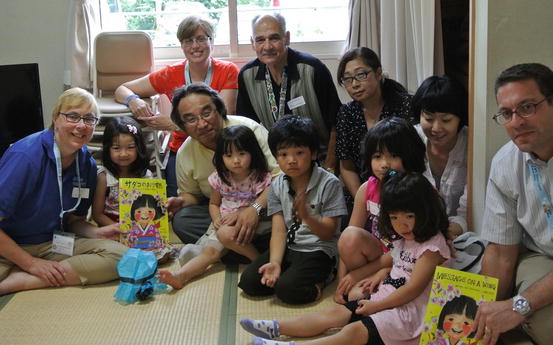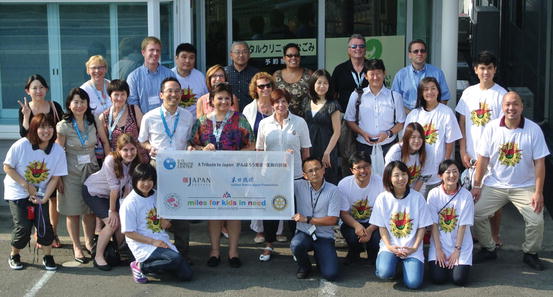Fig. 7.1
Crane sculpture made of recovered World Trade Center steel, 2012
This community outreach mission was the product of a collaborative effort involving multiple organizations in the United States and Japan. Shortly after 3/11, the Japanese Medical Society of America and Mount Sinai Hospital, a major medical center in New York City, became involved with mental health outreach by partnering with Fukushima Medical University in Fukushima City. With financial and logistic support from Rotary Clubs in both countries, as well as several other foundations and corporations, three outreach missions took place in October 2012, August 2013, and July 2014.
The trip itineraries included conferences with local and global experts discussing 3/11, extracurricular school programs with children affected by the disaster, dialogues at temporary housing shelters, attending local Rotary meetings to interact with the community leaders, and special services at national temples and shrines to foster appreciation of the spiritual significance of 3/11. Trip members visited towns in all three prefectures affected by 3/11 (Miyagi, Fukushima, and Iwate). The first trip also included an American schoolgirl who aided in outreach to schools by delivering written messages and origami Empire State Buildings from her New York City classmates.
Participants on the second and third trips returned to many of the same places as the first trip in order to provide a sense of continuity. Members of this collaboration also published a children’s storybook based on the story of Sadako and her cranes, Message on a Wing, which captures how the crane provided a vehicle for Japanese and Americans to console each other after 9/11 and 3/11 without any need for translation. More than 10,000 copies were distributed to all elementary schools and public libraries in Fukushima Prefecture, and English-language versions went to several schools in the United States to promote mutual understanding of 9/11 and 3/11 (Fig. 7.2).


Fig. 7.2
Sharing Message on a Wing with children in Iwate, 2013
The most recent outreach mission in July 2014 was the subject of this study. Seven docents from the 9/11 Tribute Center joined two physicians from Mount Sinai (R.Y. and C.K.), three medical students (P.P., T.P., and D.A.), and three Rotary Club members to visit areas affected by 3/11 and speak with residents and local Rotarians (Fig. 7.3).


Fig. 7.3
Participants on outreach trip, 2014
7.3 Impact of the Survivor Exchange Trips on Japanese Rotary Club Members
In the first part of this study, we administered a survey to Japanese Rotarians that included demographic information, ratings of the trips’ significance, and the Posttraumatic Growth Inventory (PTGI) [10, 11]. The survey incorporated a free-response section where Rotarians could elaborate on the trips’ significance if they chose to do so. Local Rotary Club members helped arrange the logistical details of the trip and led us around their towns, pointing out areas damaged by the disaster and introducing us to survivors, mental health workers, and other Rotarians; we relied on these same people to publicize, distribute, and collect the surveys and also to spread the message about the outreach effort to neighboring communities. In several instances, Rotarians helped to arrange local media coverage on television and in newspapers.
We collected surveys both from Rotarians who had direct contact with the trip members and from Rotarians belonging to other local clubs that did not meet with the trip members. Those who were unable to turn in the surveys in person faxed them back anonymously to a central office.
We collected 122 responses from members of ten different Rotary Clubs in Miyagi, Fukushima, Saitama, and Nara prefectures. Eighty respondents (66 %) were members of clubs that were visited on the 2014 mission (Kesennuma, Koriyama West, Nara, Saitama, and Sendai); the remaining 42 respondents were members of other clubs in the Koriyama area and served as a control group. The respondents were 89 % male, and 78 % were 50 years of age or older. Forty-seven percent had been active in their clubs for over 10 years. Seventy-two percent of the club members in Miyagi and Fukushima prefectures reported being involved in 3/11 relief efforts at some point since the disaster, and nearly half of those reported current involvement. Eighteen of the 122 people who responded (15 %) elaborated on their feelings about the outreach effort in the free-response section.
To assess their familiarity with the project, we asked respondents if they knew how many trips had occurred, including the current 2014 visit. Using a 0–4 scale, with 0 being insignificant and 4 being the most significant, respondents rated the value of the trips to themselves, to their Rotary Clubs, and to their communities, as well as relative to other post-3/11 outreach efforts that they may have experienced. Finally, the Rotarians rated their opinion of the long-term sustainability of the visits on the same 0–4 scale. Data were analyzed using chi-square, t-tests, and repeated-measures ANOVA in SPSS version 22.
Rotarians whose clubs had been visited on the current trip were significantly more likely to be familiar with the project and recall correctly how many trips had occurred than Rotarians whose clubs had not been visited (χ 2(1, N = 114) = 10.72, p = 0.001). These Rotarians were also statistically more likely than those who were not visited to rate the trips’ significance higher on every measure: to themselves (p = 0.004), to their clubs (p = 0.002), to their communities (p = 0.007), and in comparison to other post-3/11 efforts (p = 0.008) (Table 7.1). They also agreed more strongly that the trips were sustainable (p = 0.002) and strengthened bonds between survivors of different disasters (p = 0.023). Recalling the correct number of trips was also significantly associated with an increased impact rating to the respondents’ Rotary Clubs (p = 0.024) and their cities (p = 0.021).
Table 7.1
Rotarian trip impact scores
Club interacted with 9/11 trip | t value | ||
|---|---|---|---|
Yes (n = 78) | No (n = 40) | ||
Personal significance | 3.38 (0.84) | 2.87 (0.95) | 2.98, p = 0.004 |
Rotary significance | 3.48 (0.75) | 2.93 (0.97) | 3.16, p = 0.002 |
Community significance | 3.33 (0.89) | 2.85 (0.95) | 2.73, p = 0.007 |
Significance vs. other efforts | 3.18 (0.86) | 2.73 (0.88) | 2.69, p = 0.008 |
Feel visits are sustainable | 3.32 (0.80) | 2.70 (1.09) | 3.19, p = 0.002 |
Feel visits deepen bonds | 3.19 (0.84) | 2.80 (0.94) | 2.31, p = 0.023 |
The Rotarians’ PTGI responses were analyzed by examining individual subset scores in the categories “Relating to Others,” “New Possibilities,” “Personal Strength,” “Spiritual Change,” and “Appreciation of Life” [10]. The Rotarians’ PTGI subset scores were not associated with whether their club had interacted with the 9/11 trip, whether their club was in a region affected by the triple disaster, or whether they had become involved in 3/11 relief (Table 7.2). Those who remained involved also had higher scores in the subcategories “Relating to Others” (p = 0.01) and “New Possibilities” (p = 0.001). A repeated measures mixed ANOVA revealed that, although there were no differences in the level of any posttraumatic growth (PTG) domains between those who had an interaction and those who did not, survivors reported a significantly higher level of PTG in the domain of “Appreciation of Life,” followed by “Relating to Others” and “New Possibilities” (p < 0.001). They reported significantly lower levels of PTG in the domains of “Spiritual Change” and “Personal Strength.”
Table 7.2
Rotarian PTGI subset scores
Club interacted with 9/11 trip | t value | ||
|---|---|---|---|
Yes | No | ||
Relating to others | 3.01 (1.02) | 3.00 (1.05) | 0.09, p = 0.93 |
New possibilities | 2.94 (1.13) | 2.71 (1.10) | 1.02, p = 0.31 |
Personal strength | 2.66 (1.12) | 2.51 (1.04) | 0.67, p = 0.50 |
Spiritual change | 2.16 (1.33) | 1.80 (1.18) | 1.41, p = 0.16 |
Appreciation of life | 3.38 (0.99) | 3.48 (1.05) | 0.50, p = 0.62 |
Club in affected region | t value | ||
Yes | No | ||
Relating to others | 3.05 (1.00) | 2.80 (1.14) | 0.92, p = 0.36 |
New possibilities | 2.91 (1.14) | 2.64 (1.05) | 0.92, p = 0.36 |
Personal strength | 2.70 (1.03) | 2.11 (1.36) | 1.66, p = 0.11 |
Spiritual change | 2.01 (1.26) | 2.22 (1.47) | 0.60, p = 0.55 |
Appreciation of life | 3.48 (0.99) | 3.00 (1.01) | 1.84, p = 0.07 |
Involved in 3/11 relief | t value | ||
Yes | No | ||
Relating to others | 3.10 (1.05) | 3.03 (0.66) | 0.21, p = 0.84 |
New possibilities | 2.96 (1.10) | 2.56 (1.08) | 1.05, p = 0.30 |
Personal strength | 2.67 (1.08) | 2.67 (1.17) | 0.02, p = 0.99
Stay updated, free articles. Join our Telegram channel
Full access? Get Clinical Tree
 Get Clinical Tree app for offline access
Get Clinical Tree app for offline access

|


